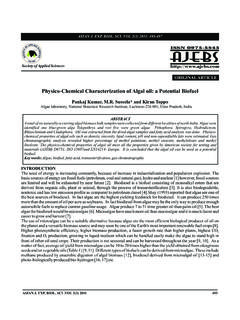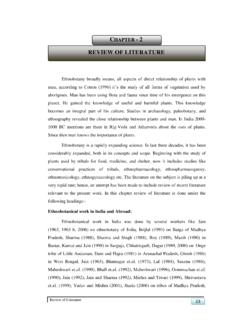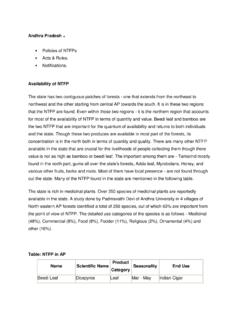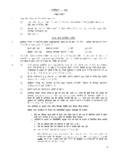Transcription of Ethnomedicinal Plants Used as Medicine by the Kurumba ...
1 ASIAN J. EXP. BIOL. SCI. VOL 2(1) 2011: 140-142. Society of Applied Sciences SHORT COMMUNICATION. ORIGINAL ARTICLE. Ethnomedicinal Plants Used as Medicine by the Kurumba Tribals in pennagaram Region, dharmapuri district of Tamil Nadu, India C. Alagesaboopathi Department of Botany, Government Arts College (Autonomous), Salem - 636 007. Tamilnadu, India. ABSTRACT. The aim of present research was to record the indigenous knowledge about medicinal Plants of Kurumba tribals in pennagaram Region, dharmapuri district of Tamilnadu. The indigenous knowledge of the tribals and the native Plants used for medicinal value were collected through questionnaire and personal interviewed during field trips.
2 The study revealed some unknown medical used of medicinal Plants . The botanical name, local name, family name, parts used and traditional practice of 20 species, 20 genera and families are discussed here for the treatment of various ailments. The dicotyledons are represented by 18 species of 18 genera and 13 families while monocotyledons are represented by 2 species of 2 genera and 2. families. 90% dicotyledons and 10% monocotyledons were encountered. KEYWORDS: Ethnomedicinal Plants , Traditional practice, Kurumba tribals, pennagaram region. INTRODUCTION. India is endowed with a rich wealth of medicinal Plants . In India, medicinal Plants are widely used by all sections of people either directly as folk remedies or indifferent indigenous systems of Medicine or indirectly in the pharmaceutical preparations of modern medicines.
3 Medicinal Plants have been used to cure a number of diseases. India is one of the 12 megadiversity countries in the world and has 17,000 flowering Plants of the designed 25 hotspots in the world, the Eastern Himalaya and the Western Ghats are the 2 hotsposts in India. In India 550 ethnic tribes having rich traditional and indigenous knowledge. Plants have been used in traditional Medicine for several thousand years [1]. The knowledge of medicinal Plants has been accumulated in the course of many centuries based on different Indian systems of medicines such as Ayurveda, Unani and Siddha. In India it is reported that traditional healers use 2500 plant species and Medicine [2].
4 In recent years, there has been a tremendous range of interest in the medicinal Plants especially those used in Ayurvedas and other traditional systems of medicines. Drugs obtained from plant are believed to be much safer and exhibit a remarkable efficacy in the treatment of various ailments [3]. Plants have always been the source of medicines and have many uses to mankind. According to some earlier workers [4-6]. The notable contributions of ethnobotanical interests on Tamilnadu are by Ramachandran and Nair (1981), Ansari and Dwarakan (1993) [7, 8] and in Indian prospective by Kaushik (1988) and Kaushik and Dhiman (2000) [9, 10].
5 After Gamble (1915-36) the flora of dharmapuri district was studied by Vajravelu et al., 1967 [11, 12]. pennagaram o o region is situated in dharmapuri district of Tamilnadu lying at 12 7'N latitude and 78 38'E. The annual mean rainfall of this region is cm with an elevation range of 270 m to 900 m from In the present study, 20 medicinal plant species were surveyed to asses their therapeutic significance in managing various ailments. Ethnomedicinal exploration was conducted in the different localities of the pennagaram region and numbers of valuable data on the uses of indigenous medicinal Plants were recorded. 140 ASIAN J. EXP.
6 BIOL. SCI. VOl 2 (1) 2011. 21. Ethnomedicinal Plants ..in pennagaram Region, dharmapuri district of Tamil Nadu, India C. Alagesaboopathi MATERIALSAND METHODS. Periodic field surveys for ethnobotanical exploration were undertaken during December 2009 to March 2010 in pennagaram region of dharmapuri district . During the surveys personal interviewed were conducted with the tribals ( Kurumba ), the herbal Medicine practioners, village dwellers and other traditional healers. Each of the plant material was assigned field book number and documented as to family, botanical name, local name (Tamil), part used and medicinal uses. Plant parts that were identified as having use in ethnobotany were collected and compressed.
7 Plant species collected were identified with the help of flora books [11, 13, 14]. Voucher specimens are deposited in the herbarium of Botany Department, Government Arts College (Autonomous), Salem. It was found that some of the present information has not so far been available in literature. RESULTSAND DISCUSSION. In the present investigation provides an ethnobotanical data of the medicinal Plants used by the tribal people of Kurumbas to cure various ailments. Out of 20 plant species studied 2 is monocot and 18 is dicot. All the 20 species have medicinal uses. Six species are used for snake bite and scorpion sting. Calotropis gigantea, Cocculus hirsutus and Withania somnifera are used for stomachache problems.
8 tribal people also make use of Cocculus hirsutus, Ocimum tenuiflorum and Rhinacanthus nasutus to treat antipyretic. Azadirachta indica used to manage small pox. The tribal people of Pennagram region, dharmapuri district of Tamilnadu has been using numerous herbs of therapeutic purpose since time immemorial. tribal people chiefly depend on the herbs for all ailments. They are aware of the plant remedies for common diseases like ulcer, skin diseases, headache, cold, cough and fits. They are also very familiar with the antidotes for scorpion sting, insect bites and snake bites. Pharmacological and Clinical trails will help in the confirmation of the efficacy of the report herbs.
9 Due to more demand of Ethnomedicinal Plants and cultivation and more profit, tribals have been motivated for conservation of these plant species. ENUMERATION. The plant species are arranged alphabetical order. Each plant is followed by its family, local name. The medicinal uses are described with details such as part(s) used singly, combination with other ingredients or mixed with other Plants , methods of preparation and mode of administration, followed by collectors initials ( ) and collection number. The following is the list of 20 Plants studied. 1. Acalypha indica L. (Euphorbiaceae). Local name: Kuppaimeni. CA-31. The leaves are ground with leaves of Ocimum teniflorum and hot water and given once a day for 2 days for stomach pain.
10 Leaf juice is given orally twice a day for cure diarrhoea in cattle. 2. Adhatoda vasica Nees (Acanthaceae). Local name: Adathoda. CA-17. The leaves are grinding with Zingiber officinalis and mixed with Piper betle leaves juice is given to cure fits. 3. Aegle marmelos (L.) Corr. (Rutaceae). Local name: Vilvam. CA-19. The leaf is grinding with curd and given once a day for 4 days for cooling. 4. Ailanthus excelsa Roxb. (Simaroubaceae). Local name: Peeyamaram. CA-24. A decoction of the leaves with the leaves of Aristolochia indica mixed with goats' milk to drink which cure scorpion sting and snake bite. 5. Aloe barbadensis Mill. (Liliaceae).







